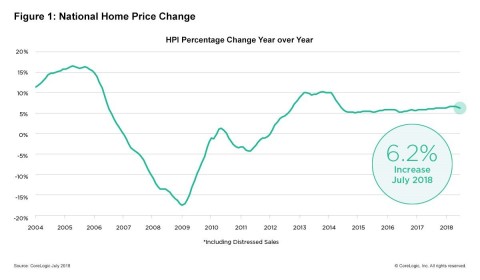- Homeowners feel they are in a “sellers’ market” and staying put for higher returns
- Washington, Nevada and Idaho post double-digit annual price growth again in July
- Home prices projected to increase by 5.1 percent by July 2019
IRVINE, Calif. — (BUSINESS WIRE) — September 4, 2018 — CoreLogic® (NYSE: CLGX), a leading global property information, analytics and data-enabled solutions provider, today released the CoreLogic Home Price Index (HPI™) and HPI Forecast™ for July 2018, which shows home prices rose both year over year and month over month. Home prices increased nationally by 6.2 percent year over year from July 2017 to July 2018. On a month-over-month basis, prices increased by 0.3 percent in July 2018 compared with June 2018. (June 2018 data was revised. Revisions with public records data are standard, and to ensure accuracy, CoreLogic incorporates the newly released public data to provide updated results each month.)
This press release features multimedia. View the full release here: https://www.businesswire.com/news/home/20180904005216/en/

CoreLogic National Home Price Change; July 2018. (Graphic: Business Wire)
Looking ahead, the CoreLogic HPI Forecast indicates that the national home-price index is projected to continue to increase by 5.1 percent on a year-over-year basis from July 2018 to July 2019. On a month-over-month basis, home prices are expected to decrease by 0.2 percent from July to August 2018. The CoreLogic HPI Forecast is a projection of home prices that is calculated using the CoreLogic HPI and other economic variables. Values are derived from state-level forecasts by weighting indices according to the number of owner-occupied households for each state.
“With increased interest rates and home prices, the CoreLogic Home Price Index is rising at a slower rate than it was earlier this year,” said Dr. Frank Nothaft, chief economist for CoreLogic. “While markets in the western part of the country continue to experience rapid home-price growth, many of those metros are overvalued, and will likely experience a slowdown soon.”
According to the CoreLogic Market Condition Indicators (MCI), an analysis of housing values in the country’s 100 largest metropolitan areas based on housing stock, 40 percent of metropolitan areas have an overvalued housing market as of July 2018. The MCI analysis categorizes home prices in individual markets as undervalued, at value or overvalued, by comparing home prices to their long-run, sustainable levels, which are supported by local market fundamentals (such as disposable income). Additionally, as of July 2018, 20 percent of the top 100 metropolitan areas were undervalued, and 40 percent were at value. When looking at only the top 50 markets based on housing stock, 50 percent were overvalued, 12 percent were undervalued and 38 percent were at value. The MCI analysis defines an overvalued housing market as one in which home prices are at least 10 percent higher than the long-term, sustainable level. An undervalued housing market is one in which home prices are at least 10 percent below the sustainable level.
In 2018, CoreLogic together with RTi Research of Norwalk, Connecticut, conducted an extensive consumer housing sentiment study, combining consumer and property insights. The study assessed attitudes toward homeownership and the drivers of the home buying or renting decision process. The July CoreLogic Market Condition Indicators (MCI) data reveals that 50 percent of the top 50 markets are considered overvalued. However, residents in many of these high-price growth markets have expectations that might be at odds with this reality. Figure 2 shows that 62 percent of residents in these markets expect their homes will be worth more in three years than they are today. Meanwhile, 55 percent of residents in no/negative growth markets believe their homes will be worth either the same or less in three years than they are today. Additionally, 47 percent of residents in high-price growth markets and 31 percent in lower growth markets feel they are in a “sellers’ market.”
“Many consumers see their homes as good investments,” said Frank Martell, president and CEO of CoreLogic. “Our consumer research indicates homeowners, especially those in high-price growth markets, are confident that by waiting to sell, they will receive a greater return on investment than they would today. In other words, sellers are largely staying put. With fewer homes on the market, price pressure will continue to rise.”
Methodology
The CoreLogic HPI™ is built on
industry-leading public record, servicing and securities real-estate
databases and incorporates more than 40 years of repeat-sales
transactions for analyzing home price trends. Generally released on the
first Tuesday of each month with an average five-week lag, the CoreLogic
HPI is designed to provide an early indication of home price trends by
market segment and for the “Single-Family Combined” tier, representing
the most comprehensive set of properties, including all sales for
single-family attached and single-family detached properties. The
indices are fully revised with each release and employ techniques to
signal turning points sooner. The CoreLogic HPI provides measures for
multiple market segments, referred to as tiers, based on property type,
price, time between sales, loan type (conforming vs. non-conforming) and
distressed sales. Broad national coverage is available from the national
level down to ZIP Code, including non-disclosure states.








